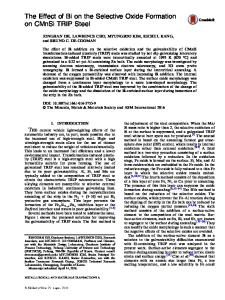The effect of steel chemistry on the formation of Fe-Zn intermetallic compounds of galvanneal-coated steel sheets
- PDF / 3,325,700 Bytes
- 10 Pages / 603.28 x 783.28 pts Page_size
- 58 Downloads / 339 Views
I.
INTRODUCTION
ZINC-COATED steel sheets are extensively used in automobiles to protect the car body from corrosion. Many processes are used to produce Zn coatings, such as electrogalvanizing, hot dipping, galvannealing, and Zn vapor deposition. The technology for Fe-Zn alloy coatings produced by galvannealing has made a dramatic improvement in terms of coating performance as compared with pure Zn coatings. The improvement includes corrosion resistance, weldability, and paintability in addition to energy and material savings. However, a serious obstacle, the tendency of powdering and flaking during press-forming processes, prevents the use of the galvannealing process as the dominant steel-coating technology. It is generally believed that the performance of coated steel sheets, particularly during forming operations, is closely related to the microstructure of coating. A number of empirical hypotheses, which relate the presence of various Fe-Zn intermetallic phases to the powdering and flaking tendency of galvanneal coatings, have been proposed, t'~l However, they are contradictory to each other due to the limitation in microstructural information, the ambiguity in phase identification, and the variance in the methods used to determine the powdering tendency by various investigators. An effort is now being made to use common techniques to determine the powdering and flaking behavior of the coatings during forming processes. Therefore, if reliable information on phases and their microstructure should become available, one can design the galvannealing process that gives the optimum performance for a specific forming process. Several techniques have been used to characterize the microstructure of Zn-base coatings. The chemical-etching technique on cross-sectional samples is the most commonly used method for its simplicity, t5,6~ However, its C.S. LIN, Graduate Student, and M. MESHI/, John Evans Professor, are with the Steel Resource Center and Department of Materials Science and Engineering, Northwestern University, Evanston, IL 60208. Manuscript submitted October 15, 1993. METALLURGICAL AND MATERIALS TRANSACTIONS B
limitation in spatial resolution fails to reveal the details of microstructure. The electron probe microanalysis (EPMA) has been used to identify the phases revealed by chemical etching, tTl The EPMA analyzer, whose best estimated spatial resolution is about 1 /xm, is often unreliable in identifying a phase with a size less than the spatial resolution of the analyzer (e.g., F phase with thickness less than 1 /xm). The X-ray diffraction technique is frequently used to identify the phases in galvanneal coatings, but it cannot be used to determine their distribution nor to detect a phase with a small volume fraction. The crystallographic orientation relationships between coating and substrate or between phases present in the coating, the detail grain morphology, and the size distribution, which are important in determining mechanical properties, must be obtained by other techniques. The ultramicrotome tech
Data Loading...










